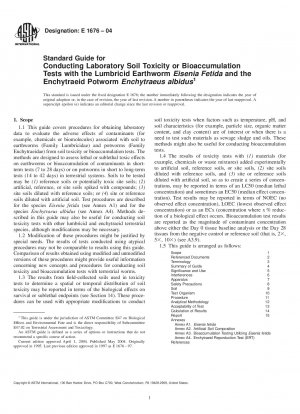ASTM E1676-04
Standard Guide for Conducting Laboratory Soil Toxicity or Bioaccumulation Tests with the Lumbricid Earthworm Eisenia Fetida and the Enchytraeid Potworm Enchytraeus albidus
- Standard No.
- ASTM E1676-04
- Release Date
- 2004
- Published By
- American Society for Testing and Materials (ASTM)
- Status
- Replace By
- ASTM E1676-12
- Latest
- ASTM E1676-12(2021)
- Scope
1.1 This guide covers procedures for obtaining laboratory data to evaluate the adverse effects of contaminants (for example, chemicals or biomolecules) associated with soil to earthworms (Family Lumbricidae) and potworms (Family Enchytraeidae) from soil toxicity or bioaccumulation tests. The methods are designed to assess lethal or sublethal toxic effects on earthworms or bioaccumulation of contaminants in short-term tests (7 to 28 days) or on potworms in short to long-term tests (14 to 42 days) in terrestrial systems. Soils to be tested may be (1) reference soils or potentially toxic site soils; (2) artificial, reference, or site soils spiked with compounds; (3) site soils diluted with reference soils; or (4) site or reference soils diluted with artificial soil. Test procedures are described for the species Eisenia fetida (see ) and for the species Enchytraeus albidus (see ). Methods described in this guide may also be useful for conducting soil toxicity tests with other lumbricid and enchytraeid terrestrial species, although modifications may be necessary.
1.2 Modification of these procedures might be justified by special needs. The results of tests conducted using atypical procedures may not be comparable to results using this guide. Comparison of results obtained using modified and unmodified versions of these procedures might provide useful information concerning new concepts and procedures for conducting soil toxicity and bioaccumulation tests with terrestrial worms.
1.3 The results from field-collected soils used in toxicity tests to determine a spatial or temporal distribution of soil toxicity may be reported in terms of the biological effects on survival or sublethal endpoints (see Section ). These procedures can be used with appropriate modifications to conduct soil toxicity tests when factors such as temperature, pH, and soil characteristics (for example, particle size, organic matter content, and clay content) are of interest or when there is a need to test such materials as sewage sludge and oils. These methods might also be useful for conducting bioaccumulation tests.
1.4 The results of toxicity tests with (1) materials (for example, chemicals or waste mixtures) added experimentally to artificial soil, reference soils, or site soils, (2) site soils diluted with reference soils, and (3) site or reference soils diluted with artificial soil, so as to create a series of concentrations, may be reported in terms of an LC50 (median lethal concentration) and sometimes an EC50 (median effect concentration). Test results may be reported in terms of NOEC (no observed effect concentration), LOEC (lowest observed effect concentration) or as an ECx (concentration where x % reduction of a biological effect occurs. Bioaccumulation test results are reported as the magnitude of contaminant concentration above either the Day 0 tissue baseline analysis or the Day 28 tissues from the negative control or reference soil (that is, 2, 5, 10) (see ).
1.5 This guide is arranged as follows:
Scope Referenced Documents Terminology Summary of Guide Significance and Use Interferences Apparatus Safety Precautions Soil Test Organism Procedure Analytical Methodology Acceptability of Test Calculation of Results Report Annexes .Eisenia fetida .Artificial Soil Composition .Bioaccumulation Testing Utilizing Eisenia fetida .Enchytra...... ASTM E1676-04 Referenced Document
- ASTM D4447 Standard Guide for Disposal of Laboratory Chemicals and Samples
- ASTM D653 Standard Terminology Relating to Soil, Rock, and Contained Fluids
- ASTM E1023 Standard Guide for Assessing the Hazard of a Material to Aquatic Organisms and Their Uses
- ASTM E1383
- ASTM E1688 Standard Guide for Determination of the Bioaccumulation of Sediment-Associated Contaminants by Benthic Invertebrates
- ASTM E1706 Standard Test Method for Measuring the Toxicity of Sediment-Associated Contaminants with Freshwater Invertebrates
- ASTM E380 Standard Practice for Use of the Internation System of Units (SI) (the Modernized Metric System)
- ASTM E943 Standard Terminology Relating to Biological Effects and Environmental Fate
ASTM E1676-04 history
- 2021 ASTM E1676-12(2021) Standard Guide for Conducting Laboratory Soil Toxicity or Bioaccumulation Tests with the Lumbricid Earthworm
Eisenia Fetida and the Enchytraeid PotwormEnch - 2012 ASTM E1676-12 Standard Guide for Conducting Laboratory Soil Toxicity or Bioaccumulation Tests with the Lumbricid Earthworm
Eisenia Fetida and the Enchytraeid PotwormEnchytraeus albidus - 2004 ASTM E1676-04 Standard Guide for Conducting Laboratory Soil Toxicity or Bioaccumulation Tests with the Lumbricid Earthworm Eisenia Fetida and the Enchytraeid Potworm Enchytraeus albidus
- 1997 ASTM E1676-97 Standard Guide for Conducting Laboratory Soil Toxicity or Bioaccumulation Tests With the Lumbricid Earthworm Eisenia Fetida

Copyright ©2024 All Rights Reserved